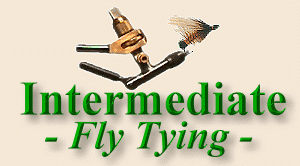Again, I saved wet flies until this time to keep the procedures fresh in
your mind when we get to the flies we'll be tying in a few weeks. This
week we'll play with soft hackles and how to wrap them around the hook to
achieve the proper look and action.
Wet flies imitate emerging insects for the most part. In larger sizes,
they also imitate small minnows, but mostly they are tied to imitate
emerging aquatic bugs. They have a breathing and swimming action that
will turn the most cautious fish into a feeding fool. I think the folks
who attended the 1999 FAOL fish-in will vouch for me on that statement.
You often read about emerging insects "drifting" to the surface of the
water to emerge. In some cases, that's true, but many insects swim to
the surface and bust through the surface tension with some force. That's
probably nature's way of making sure the insect will survive the trip.
The surface tension of the water is strong enough to hold an insect's
weight and more. Those insects who just drift to the surface (many
mayflies come to mind) often have a very hard time breaking through the
tension of the water's surface to emerge as adults. After a while, they
become exhausted or drown and just drift away in the current. Those
drifting nymphs and pupae are also prime candidates for imitation with a
wet fly.
A lot of aquatic insects put effort into the swim to the water's
surface. They swim to the surface, deflect off and swim back at it
again. Sometimes this swimming action is across the current, sometimes
it's with the current and sometimes it's against the current. That's why
you can often fish a wet fly in many different fashions and achieve good
results.
The classic wet fly swing is used to imitate active emergers. You cast
across the current, let the fly sink a little, tighten the line and let
the fly swing toward the surface, and twitch the rod tip to look like an
emerger that is pounding on the surface tension trying to break through.
Dead drifting and pulling the fly across or against the current also work
quite well. This is the time when aquatic insect life is the most
vulnerable. The fish know it and look for signs of an emerging insect.
Fish usually take wet flies with an aggressive bite.
Wet flies are exceptionally productive flies that can be fished in just
about any manner you wish to fish them. The first flies used by fly
fishermen were often wet flies or streamers. Dry flies are relatively
new creations compared to wets and streamers. If you're purely a dry fly
fisherman, consider the action you might be missing. Why fish with only
a portion of the possible offerings when you can present the fish with a
full meal deal? Think about it a moment. Are you missing out on some of
the best fly-fishing to be found?
The Deerfield Special was created to imitate emerging sedge (caddis) on
Deerfield Lake, here in the Black Hills. I use it in more places than
just lakes. The fish don't mind, they just try to eat it anywhere I use
it.
|















